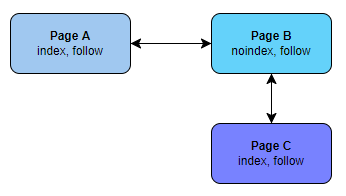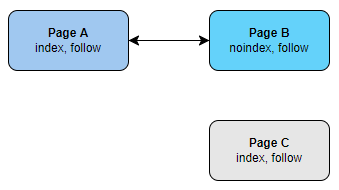Isolated URL - only found via a noindex,follow
This means that the URL in question is isolated, as it can only be found via a noindex,follow link.
Why is this important?
This is a situation where a URL exists on the network and is reachable by crawlers - but only by following a robots directive with noindex,follow:

This is a curious case because Page B is effectively saying to search engines, 'don't index this page, but please do follow all the links on it.'
In a Google Webmaster Hangout in 2017 John Mueller clarified how Google handle noindex, follow:
"It's tricky with noindex, which I think is somewhat of a misconception in general within the SEO community. With a noindex and follow it's still the case that we see the noindex. In the first step we say 'okay you don't want this page shown in the search results, we'll still keep it in our index, we just won't show it and then we can follow those links.'
If we see the noindex there for longer then we think this page REALLY doesn't want to be used in search so we will remove it completely. And then we won't follow the links anyway. So noindex and follow is essentially the same as a noindex, nofollow. There's no really big difference there in the long run."
This means that in the long run, Page B is considered to be noindex,nofollow, so Google will stop following the links. Since Page C has no incoming links from other pages, it ends up isolated from the link graph:

This means that eventually, Google will deem that this URL has no incoming internal followed links. And if a URL has no incoming internal links, this means it is not really part of the overall website structure.
Over time, this page will lose it's ability to rank for relevant search queries, and may end up being dropped from the index.
What does the Hint check?
This Hint will trigger for any internal URL that has no incoming internal links, except from pages with noindex,follow.
Examples that trigger this Hint:
Consider the URL: https://example.com/page-c
This URL only receives incoming internal links from pages which have either;
noindex,follow in the <head>:
<!doctype html>
<html lang="en">
<head>
<title>example</title>
<meta name="robots" content="noindex,follow">
...
</head>
<body>...</body>
</html>OR in the HTTP header:
HTTP/... 200 OK
...
X-Robots-Tag: noindex,followThe Hint would trigger for this URL: https://example/com/page-c
How do you resolve this issue?
Pages that are isolated in this manner will be negatively affected in the long run, even if you can't see any negative effects at the current time. This is the most important part of John Mueller's quote:
"...If we see the noindex there for longer then we think this page REALLY doesn't want to be used in search so we will remove it completely. And then we won't follow the links anyway. So noindex and follow is essentially the same as a noindex, nofollow. There's no really big difference there in the long run."
At such a point that Google stop following the links to this page, it will suffer in terms of ranking ability.
To solve this issue, you would either need to remove the noindex directive from the offending pages, or find other places in the website structure that you can link to the page, to ensure it retains link equity in Google's eyes.
 Sitebulb Desktop
Sitebulb Desktop
Find, fix and communicate technical issues with easy visuals, in-depth insights, & prioritized recommendations across 300+ SEO issues.
- Ideal for SEO professionals, consultants & marketing agencies.
 Sitebulb Cloud
Sitebulb Cloud
Get all the capability of Sitebulb Desktop, accessible via your web browser. Crawl at scale without project, crawl credit, or machine limits.
- Perfect for collaboration, remote teams & extreme scale.